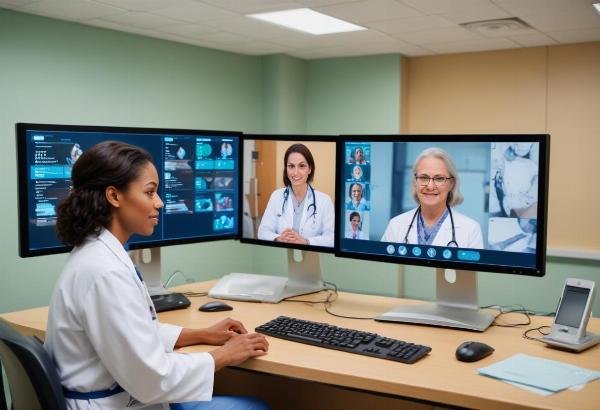 Press Releases That Rank – Boost Authority & Brand Trust Fast!
Press Releases That Rank – Boost Authority & Brand Trust Fast!
HOW TELEMEDICINE IS CHANGING THE GAME IN MENTAL HEALTH CARE
Written by Larisa Albanians » Updated on: June 17th, 2025

In recent years, telemedicine has emerged as a transformative force in the healthcare industry, breaking down barriers and providing unprecedented access to medical services. Among the various fields within healthcare, mental health has been particularly impacted by this revolution. Telemedicine is changing the game in mental health care, offering new opportunities for treatment, improving patient outcomes, and addressing long-standing challenges. In this blog, we will explore the ways telemedicine is reshaping mental health care, the benefits it brings, the challenges it faces, and its future potential.
The Evolution of Telemedicine in Mental Health
Telemedicine, defined as the remote diagnosis and treatment of patients through telecommunications technology, has its roots in the 20th century. Initially, it was used to provide healthcare services to people in remote areas. However, with the advent of the internet and advancements in digital technology, telemedicine has expanded significantly. The mental health sector, which often faces unique challenges such as stigma, accessibility, and a shortage of providers, has greatly benefited from these advancements.
Early Adoption and Growth
The adoption of telemedicine in mental health care gained traction in the early 2000s. Initially, services were limited to phone consultations and simple video conferencing. As technology advanced, so did the capabilities of telemedicine platforms. High-definition video conferencing, secure messaging, and digital health records became standard features, enabling more comprehensive and effective mental health care.
The COVID-19 Pandemic: A Catalyst for Change
The COVID-19 pandemic acted as a significant catalyst for the widespread adoption of telemedicine. With lockdowns and social distancing measures in place, traditional in-person mental health services faced severe disruptions. Telemedicine quickly became a lifeline for many patients and providers, facilitating continuous care despite physical restrictions. The pandemic demonstrated the feasibility and effectiveness of telemedicine, leading to broader acceptance and integration into mainstream mental health care.
Benefits of Telemedicine in Mental Health Care
Telemedicine offers a multitude of benefits for mental health care, addressing many of the field's persistent challenges and opening new avenues for treatment and support.
Increased Accessibility
One of the most significant advantages of telemedicine is its ability to increase accessibility to mental health services. Geographic barriers, which have historically limited access to care for individuals in rural or remote areas, are effectively eliminated. Patients can connect with mental health professionals from the comfort of their homes, reducing the need for travel and making it easier to schedule appointments.
Convenience and Flexibility
Telemedicine provides unparalleled convenience and flexibility. Patients no longer need to take time off work, arrange childcare, or navigate traffic to attend appointments. This flexibility can be particularly beneficial for individuals with busy schedules or those who may find it difficult to leave their homes due to anxiety or other mental health conditions. Additionally, telemedicine platforms often offer more flexible scheduling options, including evening and weekend appointments.
Reduced Stigma
Stigma remains a significant barrier to seeking mental health care. Telemedicine offers a level of privacy and anonymity that can help reduce this stigma. Patients can attend sessions from their own private space, without the fear of being seen entering a mental health clinic. This increased privacy can encourage more people to seek the help they need.
Continuity of Care
Telemedicine facilitates better continuity of care, which is crucial for effective mental health treatment. Patients can maintain regular contact with their providers, even if they relocate or travel frequently. This consistent access to care can help prevent relapses and ensure ongoing support for individuals managing chronic mental health conditions.
Cost-Effectiveness
Telemedicine can be more cost-effective for both patients and providers. For patients, the elimination of travel expenses and the potential for lower consultation fees can make mental health care more affordable. Providers can also reduce overhead costs associated with maintaining physical office spaces. Additionally, telemedicine can help optimize appointment schedules, reducing no-show rates and increasing overall efficiency.
Enhanced Provider Collaboration
Telemedicine platforms often come equipped with tools that facilitate better collaboration among healthcare providers. Secure messaging, shared digital health records, and integrated care plans enable mental health professionals to work more closely with primary care physicians, specialists, and other members of a patient's healthcare team. This collaborative approach can lead to more comprehensive and effective treatment plans.
Innovative Approaches in Telemedicine for Mental Health
Telemedicine is not just about traditional therapy sessions conducted via video call. The integration of various digital tools and innovative approaches is further enhancing the capabilities of telemedicine in mental health care.
Digital Therapeutics and Mobile Apps
Digital therapeutics and mobile apps are playing an increasingly important role in telemedicine. These tools offer a range of services, from cognitive-behavioral therapy (CBT) exercises and mindfulness practices to mood tracking and medication reminders. Apps such as Headspace, Calm, and Moodpath provide users with on-demand resources to support their mental health, complementing traditional telemedicine services.
AI and Machine Learning
Artificial intelligence (AI) and machine learning are being leveraged to improve the diagnosis and treatment of mental health conditions. AI-powered chatbots, such as Woebot and Wysa, provide immediate support and guidance to users, using natural language processing to engage in therapeutic conversations. Machine learning algorithms can also analyze patient data to identify patterns and predict potential mental health issues, allowing for earlier intervention.
Virtual Reality (VR) and Augmented Reality (AR)
Virtual reality (VR) and augmented reality (AR) are emerging as innovative tools in telemedicine for mental health. VR environments can be used for exposure therapy, helping patients confront and manage phobias, anxiety disorders, and PTSD in a controlled setting. AR can enhance therapy sessions by overlaying digital information onto the real world, providing immersive and interactive experiences that can aid in treatment.
Group Therapy and Support Groups
Telemedicine platforms are increasingly offering options for group therapy and support groups. These virtual groups can provide valuable social support and a sense of community for individuals dealing with similar mental health challenges. The convenience of attending from home can make group therapy more accessible and appealing to a broader audience.
Challenges and Considerations
While telemedicine has the potential to revolutionize mental health care, it is not without its challenges and considerations.
Technology Access and Literacy
Access to technology and digital literacy can be significant barriers for some individuals. Not everyone has reliable internet access or the necessary devices to participate in telemedicine. Additionally, older adults or those who are not tech-savvy may find it challenging to navigate telemedicine platforms. Addressing these disparities is crucial to ensure equitable access to mental health care.
Privacy and Security
Maintaining patient privacy and data security is a critical concern in telemedicine. Sensitive information is transmitted over digital platforms, making it vulnerable to breaches and cyberattacks. Providers must use secure, HIPAA-compliant platforms and educate patients about best practices for maintaining privacy during virtual sessions.
Quality of Care
There are concerns about whether telemedicine can provide the same quality of care as in-person sessions. Non-verbal cues, which play an important role in therapy, can be harder to detect through a screen. Providers must adapt their techniques and find new ways to engage with patients effectively in a virtual environment.
Regulatory and Licensing Issues
Telemedicine crosses state and national boundaries, creating regulatory and licensing challenges. Providers must navigate different state laws and regulations regarding telemedicine practice. Efforts are being made to create more uniform standards, but disparities still exist.
Reimbursement and Insurance
Reimbursement policies for telemedicine vary widely among insurance providers. While the COVID-19 pandemic prompted many insurers to expand coverage for telemedicine services, there is still uncertainty about the future of telemedicine reimbursement. Clear and consistent policies are needed to ensure that providers can sustain telemedicine services.
The Future of Telemedicine in Mental Health Care
The future of telemedicine in mental health care looks promising, with ongoing advancements and innovations poised to further enhance its capabilities.
Integration with Traditional Care
Telemedicine is likely to become a permanent fixture in mental health care, complementing rather than replacing traditional in-person services. Hybrid models that combine in-person and telemedicine appointments can offer the best of both worlds, providing flexibility and continuity while preserving the benefits of face-to-face interactions.
Expansion of Digital Tools
The development and integration of new digital tools will continue to enhance telemedicine. AI, machine learning, VR, and AR will play increasingly significant roles in diagnosis, treatment, and patient engagement. These technologies can provide more personalized and effective care, tailored to the unique needs of each patient.
Improved Accessibility and Equity
Efforts to improve access to technology and digital literacy will be essential in ensuring that telemedicine benefits all individuals, regardless of their socioeconomic status or geographic location. Programs that provide affordable devices and internet access, along with education and support, can help bridge the digital divide.
Enhanced Data Analytics
Data analytics will play a crucial role in the future of telemedicine. By analyzing large datasets, providers can gain insights into patient behaviors, treatment outcomes, and population health trends. This information can inform more effective treatment plans and public health strategies.
Policy and Regulatory Advancements
Continued efforts to standardize regulations and licensing requirements will facilitate the growth of telemedicine. Policymakers must work towards creating a supportive regulatory environment that ensures patient safety while enabling providers to practice across state and national boundaries.
Greater Focus on Preventive Care
Telemedicine can shift the focus from reactive to preventive mental health care. By providing continuous monitoring and support, telemedicine can help identify early warning signs of mental health issues and intervene before they escalate. This proactive approach can improve overall mental health outcomes and reduce the burden on healthcare systems.
Conclusion
Telemedicine is undeniably changing the game in mental health care, offering a range of benefits that address long-standing challenges and open up new possibilities for treatment and support. Increased accessibility, convenience, reduced stigma, and cost-effectiveness are just a few of the advantages that telemedicine brings. As technology continues to advance and the field of mental health care evolves, telemedicine is poised to play an increasingly integral role, providing innovative solutions and improving patient outcomes. While challenges remain, the future of telemedicine in mental health care looks bright, promising a more connected, accessible, and effective system for all.
Find details of Telemedicine App Development Solutions.
Note: IndiBlogHub features both user-submitted and editorial content. We do not verify third-party contributions. Read our Disclaimer and Privacy Policyfor details.
Copyright © 2019-2025 IndiBlogHub.com. All rights reserved. Hosted on DigitalOcean for fast, reliable performance.














